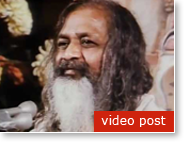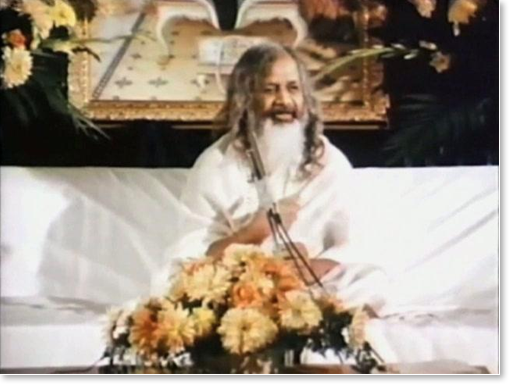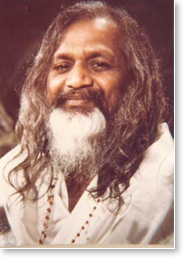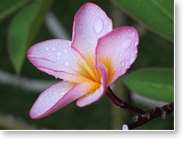 In this excerpt from a lecture at historic Jones Hall in Houston, Texas in 1972, Maharishi describes the underlying cause of suffering, the mechanics of stress release and the evolution of human consciousness to enlightenment.
In this excerpt from a lecture at historic Jones Hall in Houston, Texas in 1972, Maharishi describes the underlying cause of suffering, the mechanics of stress release and the evolution of human consciousness to enlightenment.
Maharishi:
“Suffering abides in weakness. That is all there is to it—be it of any kind. Any kind of suffering indicates weakness in the person, whether it’s emotional weakness, or intellectual weakness, or weakness of health, or weakness of anything. Any, any weakness is the cause of suffering. In this practice, when the awareness is widened, the resistance to unfoldment of pure consciousness—these resistances, they disappear. The resistance to the unfoldment of pure consciousness is like the clouds hiding the sun. The sun is shining, it’s there—only due to the clouds, the barrier comes in between us and the sun, and we fail to see it. Pure consciousness is there; pure intelligence is there. It’s there already; it does not have to be cultivated. Only the resistances for its cognition, the resistance for its full utilization in the daily life, those resistances have to go. And these resistances are stresses and strain.”
During Meditation the Mind Becomes Unbounded and the Body Loses Stress
“When the mind is opening to that unbounded pure awareness, the field of pure intelligence, simultaneously the body is losing stresses and strains, and thereby the clouds that were hindering the use of inner full creative intelligence in action, they begin to wither away.”
“During meditation, as the mental activity becomes more refined, breathing becomes more refined—and with this, metabolic rate becomes more refined, becomes less and less. The whole system receives deep rest. This deep rest automatically eliminates stresses and strains. So when the mind is opening to that unbounded pure awareness, the field of pure intelligence, simultaneously the body is losing stresses and strains, and thereby the clouds that were hindering the use of inner full creative intelligence in action, they begin to wither away.
“The system becomes purer, body becomes purer, mind becomes purer. Clearer thinking is the direct result from this practice. All values of our actions, aspirations, become richer. One saying has become popular in our movement—say, “Water the root to enjoy the fruit.” The root of life is that fundamental value of pure intelligence. This is the basis of life. Water the root, take our awareness to this, and the value of that will get inherited in the nature of the mind. Wherever the mind is, it enjoys the waves of that fullness. Every activity, every thought, becomes a wave of happiness, a wave of joyfulness. Because that pure awareness, which adheres to the nature of the mind, is bliss in its structure, in its quality—it’s bliss consciousness.”
Awareness Naturally Opens to the Unmanifest, the Cause of All Differences
“So here is something which is worth adopting in our life and worth telling our friends. When I hear from the teachers of meditation what a great joy it is to teach a man who comes worried and anxious—five, ten minutes of instruction, he says, ‘Thank you very much; I didn’t know it was so simple.’
“Many people in different parts of the world have come to ask the next day: they said, ‘It’s very good, I feel very good, but tell me what you have taught me?’ Because whatever they were told, they knew they were not making any effort on it—something effortless. But they know that they got up earlier today, and they were so fresh and did not get upset on this or this. This was a daily routine. Now the effects are seen, but they don’t know actually what they did during meditation. It came out to be so effortless, and because they did it in such an effortless manner, that is why they came to know, ‘Tell me what I did at that time—what you taught me.’ Such a natural procedure, something that is in accordance with our nature, we just spontaneously do it without even knowing what we are doing—such a natural thing.
“So this knowledge has come from a complete comprehension of life: life which is with thousands of boundaries, and that aspect of life which is boundless. These two qualities: something that is relative, something that is within boundaries, something that is full of differences; and something which is non-different, unmanifest, lying underneath all the differences, the cause of all the differences—that value of pure intelligence, unmanifest, lying at the source of thought within, and expressing itself in the channels of thinking and action. But as long as our awareness is not open to it, the full value of it is not enjoyed in our thought and action.”

Meditation and Action is the Procedure for Stabilizing Unbounded Awareness
“One closes the eyes and takes the mind out from the gross, multiple, relative existences and brings the attention to that state of unity within. This inward stroke of meditation makes the mind conversant with the quality of that basic value of life. Outward stroke of meditation brings that value out in the field of action.
“The technique is only to know it—only to bring it to our awareness and then stabilize it in our awareness for full use of it in daily life. And the principle of stabilizing, the principle of getting onto that level, is effortless. The principle of stabilizing it so that it is never lost is like the principle of dying a cloth, coloring a cloth: white cloth, dipping it in yellow color, putting it to the sun. In the sun it fades away but doesn’t fade away completely. And put it back to the color, put it back to the sun—the sun eats it up, the color enriches it. Just like that, morning and evening meditation: dipping the mind in that color of unbounded awareness, exposing it to action—in action it fades, but it doesn’t fade away completely—again back to the color of unboundedness, again back to the sun of boundaries, which scratches it from all sides.
“So coloring the mind and fading it and coloring and fading—meditation and action. This is a procedure which stabilizes that unbounded awareness on the level of conscious mind. And once it’s done, it’s done forever. The color will never fade, whatever activity we undertake, but we always remain in that state of unbounded awareness. Behaving within boundaries, we don’t lose sight of the boundless.
“So the two principles: principle of meditation is the principle of retiring. One closes the eyes and takes the mind out from the gross, multiple, relative existences and brings the attention to that state of unity within. This inward stroke of meditation makes the mind conversant with the quality of that basic value of life. Outward stroke of meditation brings that value out in the field of action.
“We go in to come out, just like we go to the bank to come out into the market. And five minutes going to the bank is worthwhile to be full day in the market. It’s worthwhile. If someone says, “I have so many appointments in the market, I don’t have time to go to the bank,” he has to be cautioned. All these appointments in the market will be valid and enjoyable and fruitful only if some five minutes are spent in the bank. If someone says, ‘I don’t have the time to meditate,’ that means he doesn’t have time to collect his mind, to enrich his mind, to make the mind full of liveliness. And in that state, he is only plunging into activity with a very narrow ability of perception, decision, action. The accomplishments are not going to be great.
“This technique, this knowledge, is so very vital to everyone’s life, no matter what one is doing.”
You can view a video of this talk by Maharishi at Jones Hall, Houston, Texas, in 1972 by clicking on the video below:






